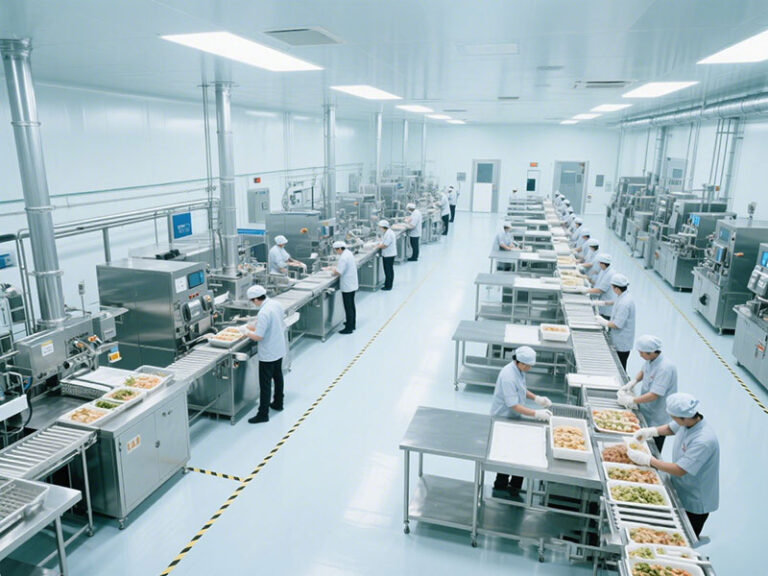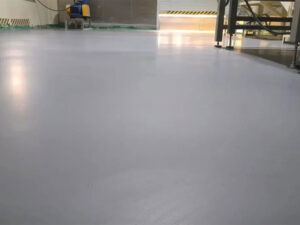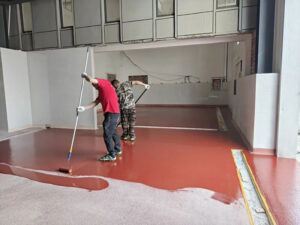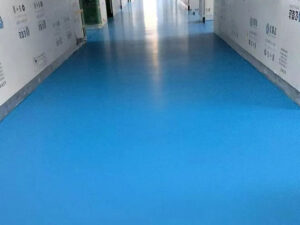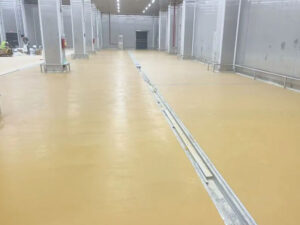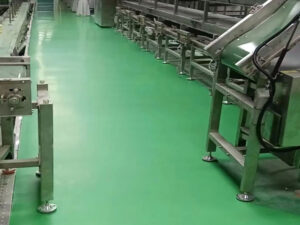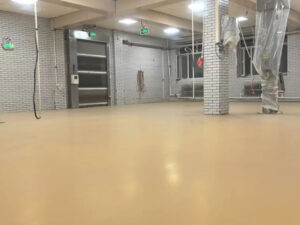I. Introduction
1.1 The importance of food industry flooring
In the food industry, flooring plays a crucial role, directly related to food hygiene and safety, employee work safety, and production efficiency. Firstly, from the perspective of food hygiene and safety, flooring is an important part of the food production environment. During the food processing process, it is inevitable that food residues, liquids, etc. will spill on the ground. If the flooring material is unhygienic and difficult to clean, it is easy to breed bacteria and microorganisms. These bacteria and microorganisms may contaminate food, thus posing potential threats to consumers’ health. For example, in some dairy product processing plants, if the flooring cannot effectively prevent the growth of bacteria, it may lead to the contamination of dairy products, causing health problems such as diarrhea and vomiting for consumers.
Secondly, the safety of the flooring is of great importance to employees. The food processing area is usually wet, and employees move around frequently during operation. If the anti – slip performance of the flooring is poor, employees are prone to slipping and getting injured, which not only affects the employees’ physical health but may also lead to production accidents and disrupt the normal production order of the enterprise. According to statistics, in the food industry, work – related injuries caused by slipping account for a relatively high proportion. In addition, the durability of the flooring also affects production efficiency and equipment service life. If the flooring is not wear – resistant or impact – resistant, it is prone to wear and damage during long – term production. This requires frequent repair and replacement, which not only increases the enterprise’s cost but also leads to production downtime and affects production efficiency. At the same time, uneven flooring may also damage equipment and shorten its service life.
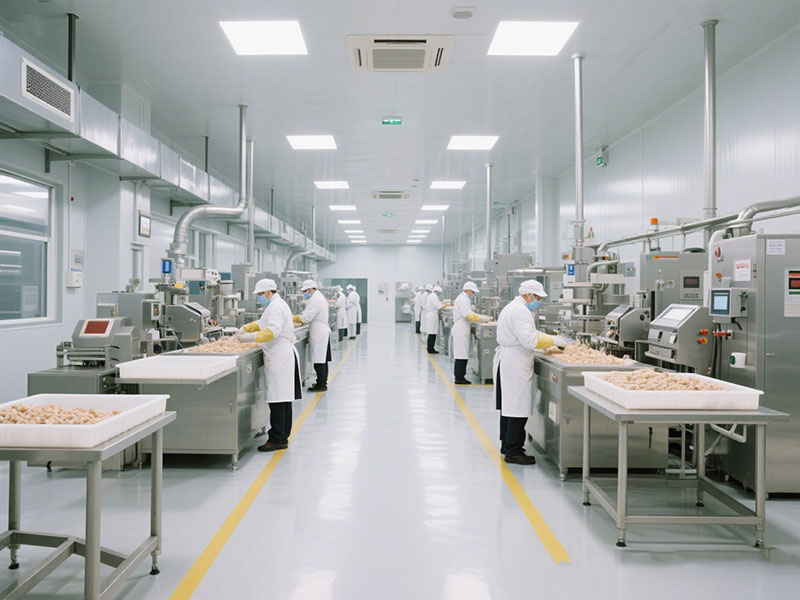
1.2 Introducing the topic: The current latest trends in food industry flooring
With the continuous development of the food industry and the increasing requirements for food safety and hygiene, food industry flooring is also constantly innovating and evolving. Understanding the current latest trends in food industry flooring is of great significance for food enterprises to select suitable flooring materials, improve production efficiency, and ensure food safety. Next, this article will delve into the latest trends in food industry flooring and relevant selection suggestions.
II. What aspects of flooring do people pay attention to?
2.1 Concerns about the performance requirements of flooring
- Hygiene and safety performance: Hygiene and safety are one of the most important performance requirements for food industry flooring. Antibacterial performance is an important indicator to measure the hygienic performance of flooring. Flooring with antibacterial function can effectively inhibit the growth and spread of bacteria and microorganisms, reducing the risk of food contamination. For example, some resin floors treated with antibacterial technology can form an antibacterial protective film on the surface to prevent the attachment and reproduction of bacteria. Anti – slip performance is also crucial. In food processing areas, the ground is often wet with water stains, oil stains, etc. Anti – slip flooring can reduce the risk of employees slipping and ensure their safety. Currently, there are many types of flooring with anti – slip textures available on the market, such as polyurethane anti – slip flooring, whose special surface texture can increase friction and improve anti – slip performance. In addition, the flooring also needs to be easy to clean, capable of quickly and thoroughly removing dirt and bacteria on the surface to maintain good hygienic conditions.
- Durability performance: In food processing areas, there are usually a large number of equipment and personnel moving around, so the flooring needs to have good durability. Wear resistance is the key, being able to withstand the movement of equipment and the trampling of personnel without obvious wear. For example, some high – strength epoxy resin floors have excellent wear – resistant performance and can still maintain a good surface condition after long – term use. Impact resistance cannot be ignored either, being able to withstand the impact of heavy objects without cracking. In some meat processing workshops, heavy objects often fall. If the impact resistance of the flooring is poor, it is easy to crack, affecting the service life of the flooring. At the same time, the flooring also needs to have chemical corrosion resistance, being able to resist the erosion of various chemicals used in the food processing process, such as acids, alkalis, and disinfectants.
- Adaptability to special environments: The production environment in the food industry is complex and diverse, and the flooring needs to adapt to different special environments. High – temperature resistance is very important in some high – temperature processing links such as baking and frying. The flooring needs to be able to withstand high temperatures without deformation or releasing harmful substances. For example, some high – temperature – resistant ceramic floors can maintain stable performance in high – temperature environments. Low – temperature resistance is suitable for cold storage and freezing environments. In cold storage rooms, the flooring needs to maintain good flexibility and strength at low temperatures to prevent cracking due to temperature changes. Moisture resistance is also essential, especially in some wet environments such as aquatic product processing and vegetable washing. Moisture – resistant flooring can prevent moisture from penetrating into the flooring and avoid mildew and deformation.
2.2 Concerns about the selection and cost of flooring
- Comparison of the advantages and disadvantages of different types of flooring: Common types of flooring in the food industry on the market include epoxy resin flooring, polyurethane flooring, and ceramic flooring. Epoxy resin flooring has good wear resistance, chemical corrosion resistance, and anti – slip performance, and its price is relatively moderate. However, the construction requirements for epoxy resin flooring are relatively high. If the construction is improper, problems such as bubbles and cracks are likely to occur. Polyurethane flooring has the advantages of good flexibility, strong anti – slip performance, easy cleaning, and good low – temperature resistance. However, the price of polyurethane flooring is relatively high, and it may soften in high – temperature environments. Ceramic flooring has the advantages of high hardness, good wear resistance, strong antibacterial performance, and beautiful appearance. However, the anti – slip performance of ceramic flooring is relatively poor, and the installation is difficult. Once damaged, the repair cost is high.
- The price range and cost – effectiveness of flooring: The price of flooring varies depending on factors such as material, brand, and quality. Generally, the price of epoxy resin flooring ranges from dozens of yuan to hundreds of yuan per square meter. The price of polyurethane flooring is relatively high, and it may range from more than one hundred yuan to several hundred yuan per square meter. The price of ceramic flooring varies according to different specifications and qualities, ranging from dozens of yuan to thousands of yuan per square meter. When selecting flooring, enterprises need to comprehensively consider the performance and price of the flooring and choose flooring with high cost – effectiveness. For example, for some enterprises with high requirements for hygiene and safety and relatively sufficient budgets, polyurethane flooring can be selected; while for some enterprises with limited budgets and relatively low requirements for flooring performance, epoxy resin flooring can be chosen.
- Installation and maintenance costs: In addition to the price of the flooring itself, installation and maintenance costs are also important factors that enterprises need to consider. Installation costs include construction fees, material transportation fees, etc. Different types of flooring have different installation difficulties, and the installation costs will also vary. For example, the installation of ceramic flooring requires professional workers and tools, and the installation cost is relatively high; while the installation of epoxy resin flooring is relatively simple, and the installation cost is low. Maintenance costs include cleaning fees, repair fees, etc. Some flooring that is easy to clean and durable has relatively low maintenance costs; while some flooring that requires special maintenance has higher maintenance costs. For example, some flooring with special coatings needs to be cleaned with specific cleaning agents, which will increase the maintenance cost.
2.3 Seeking industry standards and compliance
- Relevant regulations and requirements of FDA, USDA, etc.: In the food industry, flooring needs to comply with relevant regulations and requirements of the FDA (U.S. Food and Drug Administration), USDA (U.S. Department of Agriculture), etc. These regulations have strict provisions on the material, hygienic performance, safety performance, etc. of the flooring. For example, the FDA requires that flooring materials must be non – toxic and harmless and will not cause pollution to food; the USDA has specific requirements for the anti – slip performance and cleaning performance of the flooring. When selecting flooring, enterprises must ensure that the selected flooring meets these regulatory requirements; otherwise, they may face legal risks.
- Third – party certification and testing: To ensure that the flooring meets relevant regulatory requirements and industry standards, enterprises can choose flooring products with third – party certification and testing. Third – party certification agencies will conduct strict testing and evaluation on various performance indicators of the flooring and issue corresponding certification certificates. For example, NSF (National Sanitation Foundation) certification is one of the more authoritative certifications in the food industry. Flooring products with NSF certification have high guarantees in terms of hygiene and safety. When purchasing flooring, enterprises can require suppliers to provide relevant certification certificates and test reports to ensure the quality and compliance of the flooring.
III. The latest trends in food industry flooring
3.1 Material innovation
- Application of new resin materials: In recent years, the application of new resin materials in food industry flooring has become more and more widespread. Resin materials such as polyurethane and polyurea have excellent performance and have become new choices for food industry flooring. Polyurethane resin flooring has good flexibility, anti – slip performance, and chemical corrosion resistance, and can adapt to the complex environment of food processing areas. At the same time, the construction speed of polyurethane resin flooring is fast, and the curing time is short, which can reduce the impact on production. Polyurea resin flooring has higher strength and wear resistance and can withstand heavier loads and more frequent use. In addition, polyurea resin flooring also has good ultraviolet resistance and weather resistance, making it suitable for outdoor food processing areas.
- Promotion of environmentally friendly materials: With the increasing awareness of environmental protection, the application of environmentally friendly materials in food industry flooring has also attracted more and more attention. Flooring materials with low VOC (Volatile Organic Compound) emissions have become the mainstream in the market. These materials release relatively low levels of VOC during production and use, have less impact on indoor air quality, and are beneficial to the health of employees. For example, some water – based epoxy resin floors use water as a solvent, contain no organic solvents, and have almost zero VOC emissions. In addition, recyclable flooring materials are also gradually being favored. Some flooring made of recyclable plastics, rubber, etc. can be recycled after the end of its service life, reducing environmental pollution.
3.2 Design optimization
- Seamless and integrated design: Seamless and integrated design is an important trend in the design of food industry flooring. Seamless flooring can reduce the hiding places for bacteria and dirt, facilitating cleaning and disinfection. At the same time, seamless design can also improve the overall aesthetics and sealing performance of the flooring, preventing the penetration of liquids and gases. For example, some epoxy seamless floors using on – site casting technology can form an integral, seamless surface, effectively avoiding the problem of bacteria breeding in the seams. Integrated design involves integrating the flooring with walls, equipment, etc., eliminating the seams and dead corners in traditional designs and further improving the hygienic performance.
- Improvement of anti – slip textures and patterns: The improvement of anti – slip textures and patterns is an important means to improve the anti – slip performance of flooring. The anti – slip texture design of modern food industry flooring is more scientific and reasonable, and can provide good anti – slip performance under different environmental conditions. For example, some flooring uses micro – convex anti – slip textures. This texture can not only increase friction but also drain water, reducing the impact of water stains on anti – slip performance. In addition, the design of anti – slip patterns is also more diverse, which can not only improve anti – slip performance but also play a decorative role. For example, some flooring uses anti – slip designs with animal, plant, etc. patterns, making the flooring more beautiful.
- Diversification of colors and appearances: To meet the personalized needs of different food enterprises, the colors and appearances of food industry flooring are also becoming more and more diverse. In addition to traditional colors such as gray and white, there are now many bright colors available on the market, such as blue, green, and yellow. These colors can not only increase the aesthetics of the workplace but also play a role in distinguishing different areas. For example, in a food processing workshop, different colors of flooring can be used to distinguish the raw material area, processing area, finished product area, etc., facilitating management and operation. In addition, some flooring also uses appearance designs imitating marble, wood grain, etc., making the flooring more beautiful and high – end.
3.3 Function enhancement
- Enhancement of antibacterial and antiviral functions: In the context of the current epidemic, antibacterial and antiviral functions have become an important development direction for food industry flooring. Some new types of flooring materials use advanced antibacterial and antiviral technologies, which can effectively inhibit the growth and spread of bacteria and viruses. For example, some floors containing antibacterial components such as silver ions and copper ions can kill bacteria and viruses by releasing antibacterial ions. In addition, some flooring also uses photocatalyst technology, which can decompose bacteria and viruses under the condition of light, achieving antibacterial and antiviral effects.
- Improvement of thermal shock resistance and chemical corrosion resistance: During the food processing process, the flooring is often subjected to impacts from high temperatures, low temperatures, chemicals, etc. Therefore, the improvement of thermal shock resistance and chemical corrosion resistance is crucial. Modern food industry flooring has improved its thermal shock resistance and chemical corrosion resistance through improving material formulations and production processes. For example, some resin floors using special additives can maintain stable performance in high – temperature and low – temperature environments and are not prone to cracking or deformation. At the same time, these floors also have good chemical corrosion resistance and can resist the erosion of various acids, alkalis, disinfectants, and other chemicals.
- Integration of intelligent and sensing functions: With the continuous development of technology, intelligent and sensing functions are also gradually being integrated into food industry flooring. Some intelligent floors can monitor parameters such as the temperature, humidity, and pressure of the flooring in real – time and transmit the data to the control system. Through the analysis and processing of these data, abnormal situations of the flooring, such as over – high temperature or excessive humidity, can be detected in a timely manner, and corresponding measures can be taken for processing. For example, in some cold storage rooms, intelligent floors can monitor the temperature in real – time. When the temperature exceeds the set value, the system will automatically issue an alarm to remind the staff to take measures. In addition, some sensing floors can also detect the movement of personnel and realize functions such as automatic lighting and automatic cleaning, improving work efficiency and management level.
3.4 Convenience in installation and maintenance
- Fast installation and curing technology: Food enterprises usually hope that the installation and replacement process of the flooring can be as short as possible to reduce the impact on production. Therefore, fast installation and curing technology has become an important development trend for food industry flooring. Some new types of flooring materials use fast – curing formulations and can complete installation and curing in a short time. For example, some polyurethane floors can be cured within a few hours and can be put into use the next day. In addition, some flooring also uses modular installation technology, pre – manufacturing the flooring into modules, and only requiring splicing on – site, which greatly shortens the installation time.
- Surface treatment for easy cleaning and maintenance: To reduce maintenance costs, food industry flooring needs to have surface treatment for easy cleaning and maintenance. Some flooring uses special surface coatings, making the flooring surface smoother and less likely to be contaminated with dirt. Cleaning only requires wiping with clean water or ordinary cleaning agents. For example, some nano – coated floors have good self – cleaning performance, and it is difficult for dust and dirt to adhere to the surface. In addition, some flooring also has anti – fouling and antibacterial functions, which can effectively reduce the growth of bacteria and dirt and extend the service life of the flooring.
IV. Flooring selection suggestions for different types of food processing areas
4.1 Production workshops
Production workshops are the core areas of food processing. The flooring needs to withstand high traffic, heavy equipment, and frequent cleaning. Considering these factors, epoxy and polyurethane flooring, which are durable and easy to clean, are more suitable choices. Epoxy resin flooring has good wear resistance, chemical corrosion resistance, and anti – slip performance and can withstand the movement of equipment and the trampling of personnel. At the same time, the surface of epoxy resin flooring is smooth and easy to clean, and can quickly remove dirt and bacteria on the surface. Polyurethane flooring has better flexibility and anti – slip performance, which can reduce the risk of employees slipping. In addition, polyurethane flooring also has good low – temperature resistance and is suitable for some production workshops that require refrigeration.
4.2 Cold storage and freezer warehouses
The environment temperature in cold storage and freezer warehouses is low, so the flooring needs to have low – temperature resistance. Methyl methacrylate (MMA) or polyurethane flooring is a more suitable choice. MMA flooring has good low – temperature resistance and can maintain stable performance in low – temperature environments without cracking or deformation. At the same time, the curing speed of MMA flooring is fast, and it can be installed and put into use in a short time. Polyurethane flooring also has good low – temperature resistance and strong anti – slip performance, which can ensure the safety of employees in low – temperature environments. In addition, the flexibility of polyurethane flooring is good, and it can adapt to slight deformation of the ground.
4.3 Packaging and inspection areas
The packaging and inspection areas have high requirements for hygiene and anti – static performance. Anti – static epoxy or polyurethane flooring is an ideal choice. Anti – static flooring can effectively prevent the generation of static electricity and avoid damage to electronic equipment and food packaging caused by static electricity. At the same time, anti – static flooring also has good hygienic performance and is easy to clean and disinfect. Both epoxy resin flooring and polyurethane flooring can achieve anti – static function by adding anti – static agents. In addition, these floors can also be designed in different colors and patterns according to needs to distinguish different areas.
4.4 Employee rest and office areas
Employee rest and office areas need to provide a comfortable working environment to reduce employee fatigue. Anti – slip and soft rubber or carpet flooring is a more suitable choice. Rubber flooring has good elasticity and anti – slip performance, which can reduce the fatigue of employees standing for a long time. At the same time, rubber flooring also has sound – absorbing and sound – insulating functions, which can provide a quiet working environment. Carpet flooring is softer and more comfortable, creating a warm atmosphere. However, the cleaning and maintenance of carpet flooring are relatively difficult and require regular cleaning and replacement.
V. Case analysis
5.1 Introduction of a successful case
A food processing factory adopted new – type polyurethane resin flooring and achieved remarkable results. The ground in the production workshop of this factory was often wet with water stains, oil stains, etc. The original flooring had poor anti – slip performance, and employees slipped frequently. Moreover, the original flooring was not wear – resistant and was prone to wear and damage, which affected production efficiency. After replacing with polyurethane resin flooring, these problems were effectively solved. The anti – slip performance of polyurethane resin flooring is very good. The special surface texture can increase friction and reduce the risk of employees slipping. At the same time, the wear resistance of this flooring is also very strong, being able to withstand the movement of equipment and the trampling of personnel. After using it for a period of time, it still maintains a good surface condition. In addition, the easy – to – clean property of polyurethane resin flooring has also been recognized by employees. Cleaning only requires wiping with clean water or ordinary cleaning agents, which greatly reduces the cleaning cost. By replacing the flooring, the production efficiency of this factory has been improved, and the work safety of employees has also been guaranteed.
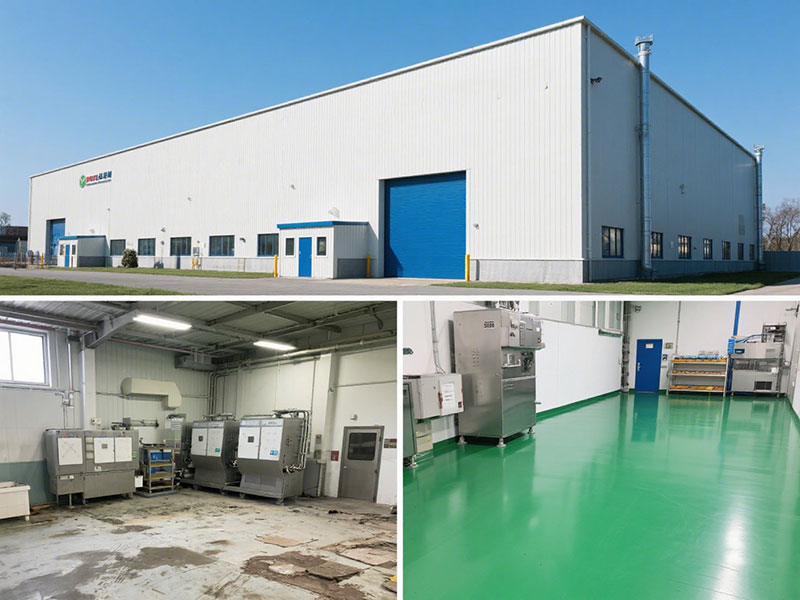
5.2 Enlightenment from the case
This successful case has important reference significance for other food enterprises. Firstly, when selecting flooring, enterprises should fully consider their own production environment and needs. Different food processing areas have different performance requirements for flooring, and enterprises need to select suitable flooring materials according to actual conditions. Secondly, attention should be paid to the quality and brand of the flooring. Choosing flooring from reliable brands with good reputations can ensure the performance and service life of the flooring. In addition, enterprises can also pay attention to the innovative technologies and development trends of flooring, and timely adopt new – type flooring materials and designs to improve production efficiency and hygiene levels. Finally, when installing and maintaining the flooring, enterprises should strictly follow the manufacturer’s requirements to ensure the installation quality and maintenance effect of the flooring.
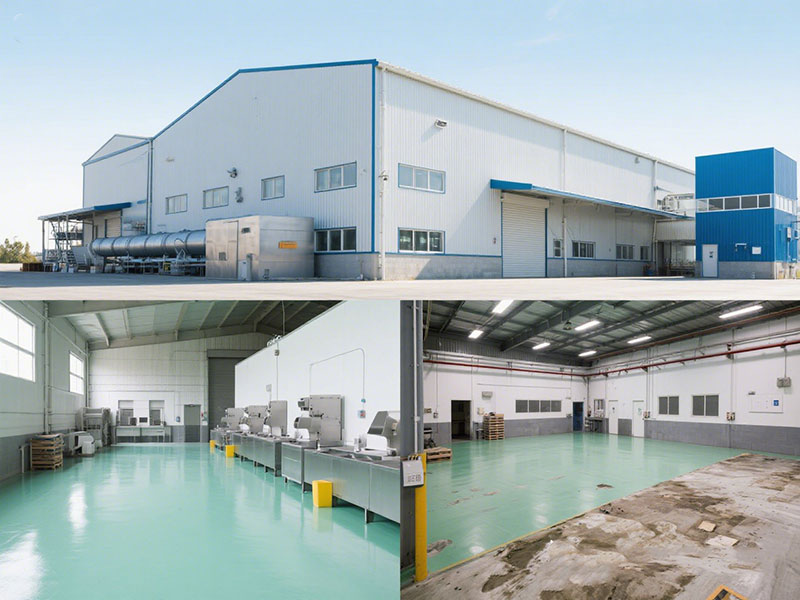
VI. Conclusion
6.1 Summarizing the latest trends in food industry flooring
In summary, the latest trends in food industry flooring mainly include material innovation, design optimization, function enhancement, and convenience in installation and maintenance. In terms of material innovation, the application of new resin materials and environmentally friendly materials is becoming more and more widespread, providing more choices for food enterprises. Design optimization is reflected in seamless and integrated design, improvement of anti – slip textures and patterns, and diversification of colors and appearances, improving the hygienic performance and aesthetics of the flooring. In terms of function enhancement, the improvement of antibacterial and antiviral functions, thermal shock resistance and chemical corrosion resistance, and intelligent and sensing functions make the flooring more adaptable to the special needs of the food industry. Convenience in installation and maintenance reduces the cost and maintenance difficulty of enterprises through fast installation and curing technology and surface treatment for easy cleaning and maintenance.
6.2 Emphasizing the importance of selecting suitable flooring for food enterprises
Selecting suitable flooring is crucial for food enterprises. Suitable flooring can ensure food hygiene and safety, reduce the risk of food contamination, and provide consumers with safe and healthy food. At the same time, suitable flooring can also improve the work safety of employees, reduce work – related injuries, and improve production efficiency. In addition, suitable flooring can also reduce the cost of enterprises, including purchase cost, installation cost, and maintenance cost. Therefore, when selecting flooring, food enterprises should fully consider factors such as the performance, price, and compliance of the flooring and choose the most suitable flooring for themselves.
6.3 Customers to pay attention to and apply these trends in engineering projects
For customers with engineering projects, paying attention to and applying the latest trends in food industry flooring is of great significance. In engineering projects, adopting new – type flooring materials and designs can improve the quality and competitiveness of the project. At the same time, paying attention to the trends of environmental protection and sustainable development and choosing environmentally friendly flooring materials also meet the development needs of society. Therefore, it is recommended that customers actively pay attention to and apply these trends in engineering projects and cooperate with professional flooring suppliers to jointly create a safe, hygienic, and efficient food processing environment.
